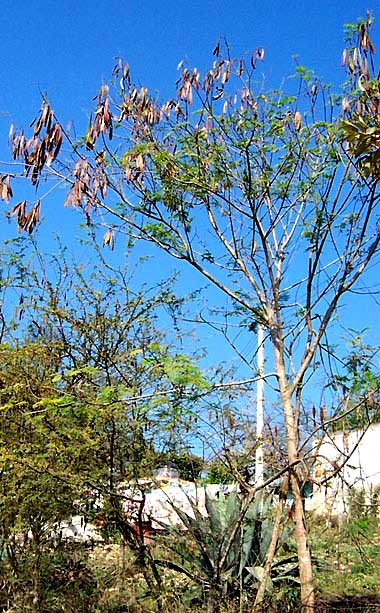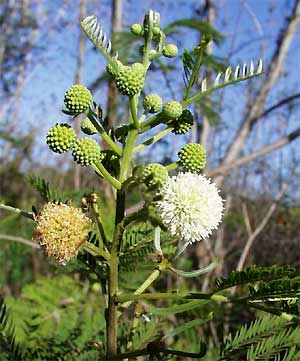
In some places around Mérida and beyond, where abandoned land is slowly reverting to low scrub, the most abundant woody tree is something that looks like a spineless Acacia. The Maya call Uaxim (wa-SHEEM), and books in English sometimes call it Wild Tamarind, though the next species also is called that. In much of Mexico it's called Guaje. It's Leucaena leucocephala, and that's it below during its mostly leafless, dry-season or winter state.

 For the most part Wild Tamarind is such a nondescript little tree that you don't notice it until deep into the dry season when it's lost most of its leave and the branches are absolutely loaded with flattish legumes a little like those of the eastern US's Redbuds. Then the trees are noticeable because, basically, they look so ratty. The flowering heads look very much like those of a typical acacia, as you can see for yourself at the right.
For the most part Wild Tamarind is such a nondescript little tree that you don't notice it until deep into the dry season when it's lost most of its leave and the branches are absolutely loaded with flattish legumes a little like those of the eastern US's Redbuds. Then the trees are noticeable because, basically, they look so ratty. The flowering heads look very much like those of a typical acacia, as you can see for yourself at the right.
Despite its less than flamboyant appearance, this is a wonderful species! For one thing, it thrives on thin, poor soil, of which the Yucatan abounds, so ecologically it's very important as a sort of pioneer species preparing the soil for more intolerant species. Also, the tree bears flowers much of the year, and the flowers are visited by an endless parade of pollinators.
Moreover, if you open a slightly immature legume when its beans are formed but the legume sides haven't yet turned brown and dry, the soft, green beans are delicious. You can nibble on them, but good Maya cooks know that their best use is to grind them up and flavor soups and stews with them. They have an unusual flavor with a hint of garlic. Eat just two or three seeds and the flavor stays with you for hours.
In the Yucatan often you see Maya farmers macheteing entire branches of Wild Tamarind to feed to their livestock, stems and all. In fact, sometimes agronomists call Wild Tamarind "the miracle tree" not only because of its worldwide success as a long-lived and highly nutritious forage tree for livestock but also because it provides firewood, timber, green manure, shade and erosion control. This native tree has been planted worldwide, and in 1990 was estimated to cover as much as 12 million acres (5 million ha) worldwide.